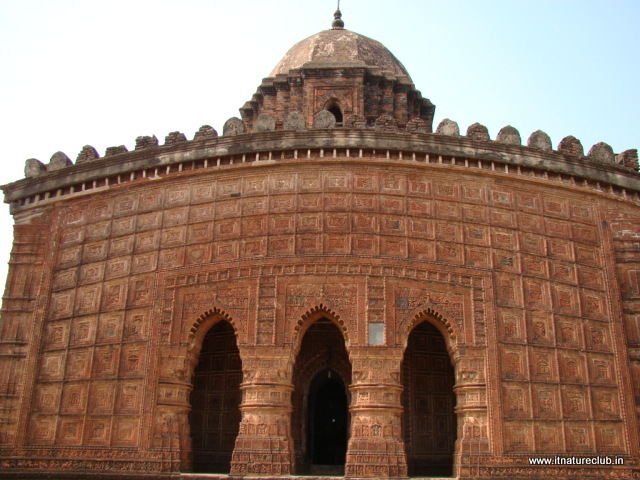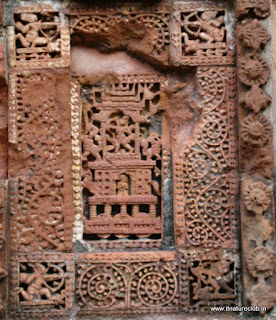Bishnupur , the heritage town of West Bengal is 5 hrs drive away from Kolkata .It was also known as Mallabhum or the Land of the Wrestlers. Thanks to the patronage of art and architecture by the local rulers , the entire region has derived its beautiful landscape of temples built in terracotta style of architecture.No wonder , the famous Bengal District Gazetteer wrote in 1908 that 'Bishnupur is more beautiful than the house of Indra in heaven'.!
This new form of temple architecture was also due to the short supply of stones in the vast flood plains of Bengal.The easily available clay resulted in burnt clay bricks, which became a good substitute to stone leading to the construction of elaborately decorated terracotta temples.
There are at least 32 temples that are considered noteworthy , out of which 22 are under the protection of ASI. Thankfully this is one of the beautifully landscaped, well maintained sites under ASI.
A must visit site if you are planning to explore West Bengal ! Its really worth it !!
It took us five hours by road to reach Bishnupur from Kolkata
The beautiful terracotta panels on the facade is very typical of all the temples here
The temples can be classified into mainly the "Chala", "Ratna" and "Dalaan" styles. The first has the curved "Bangla" roof and the curved cornice. The second is characterised by the towers, while the "Dalaan" has the flat roof
According to famous art historian Percy Brown 'the somewhat indeterminate curved effect of the upper portions conveys the impression of people bending before the elements, of yielding to them rather than defying them in view of their relentless power'
The temple walls were decorated with terracotta plaques with the intention of covering the plain laterite blocks with ornamented panels narrating stories from Puranas, Ramayana and Mahabharata.
Motifs on the outer walls, door jamb and pillars depict stories from the Krishna legends, floral and faunal motifs, geometric patterns as well as glimpses of social life
The temple of Madana-Mohana is built in brick. This temple was erected to enshrine the tutelary deity of the Mallas in c. 1694 CE. The façade of the temple was decorated with scenes showing Krishnalila episodes, scenes showing dancers and dancing party and a row of ascetics. The area upon the arches are found covered with scenes depicting war while the lower parts are found decorated with figures of animals and birds, Krishnalila, Dasavatara (ten incarnation of Vishnu) scenes, legends and stories from Puranas
One of the exceptional motif in Madana Mohana Temple is this one.An elephant formed by varied positioning of nine women with a couple seated on the back of this elephant in an amorous posture also known as Naba-Naree-Kunjar
Yes , you can see them everywhere
Rasa-Mancha with its unique architectural manifestations was built by Bir Hambir in c1600 AD.The temple stands on a raised square laterite plinth with a pyramidal superstructure.There are three successive circumambulatory galleries,arches of which are capped by " Chala " Motifs. During the Malla rule, all the idols that are worshiped in all the other Bishnupur temples were exhibited here during the Rasa festival.
It is also said that Rasa-mancha is very unique from the point of structural formation, having no similar structure anywhere , not only in Bengal but in the whole of India
This canon known as Dalmadal made of wrought iron must have been the largest cannon made by the Malla rulers.It is 3.8 mtrs long and the muzzle is 29.2 cm in diameter
This Canon is supposed to have protected citizens during the Maratha raid
You will see these famous Bankura horses in almost all the shops around the temple. Bankura horse is also the official motif of Central Cottage Industries Emporium.During the earlier days these long necked horses were made by the artisans of Panchmura village located around 10 kms from Bishnupur.It is hollow with few circular vents to facilitate uniform firing in kilns.Originally these horses were used for ritualistic purposes as they were offered as a token of devotion to Deities including at Dargahs
One of the most beautiful carving in Shyama-raya temple is this one.Rasa-chakra or dance of multiple Krishnas with Gopis on a full moon night
The inscription on the main entrance read that the temple was 'built for the pleasure of Shri Radhika and Shri Krishna'
Jor -Bangla Temple is richly decorated with exquisite terracotta panels on the facade of the porch and the three other sides.These depict scenes from the Krishnalila and scenes from daily life with breathtaking detail. The celestial kinnaras and gandharvas are shown in postures just as dynamic as mortal beings
Nearby is the temple dedicated to Chinnamastika , who is one of the ten Tantric goddesses and a ferocious aspect of Devi. Chhinnamasta's image conveys the eternal truth that "life feeds on death, is nourished by death, necessitates death, and that the ultimate destiny of sex is to perpetuate more life, which in turn will decay and die in order to feed more life. While the lotus and the lovemaking couple symbolize life and the urge to create life, in a way gives life-force to the beheaded goddess, the blood flowing from goddess conveys death and loss of the life-force, which flows into the mouths of her devotee yoginis, nourishing them
And while in Bishnupur, do visit the weavers and see there craftsmanship in weaving those beautiful Balucheri sarees to make your visit a truly memorable one !!
If you want to visit Bishnupur and other historical places in West Bengal mail us at itnatureclub@gmail.com




















































No comments:
Post a Comment